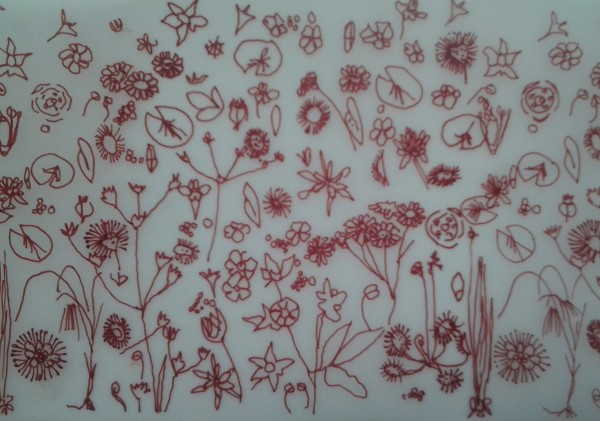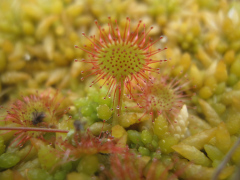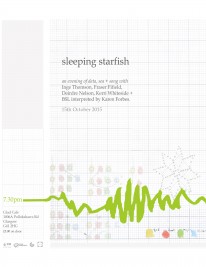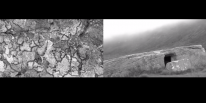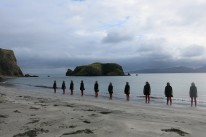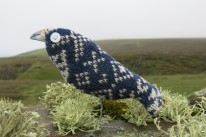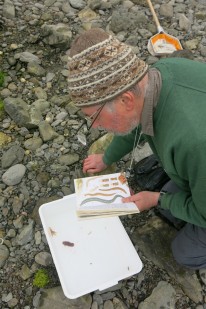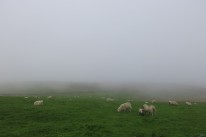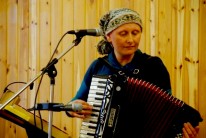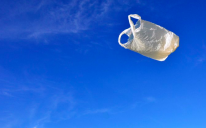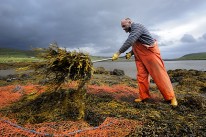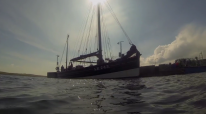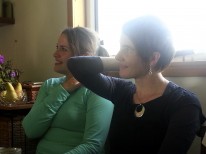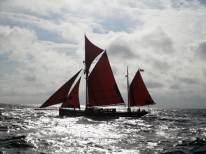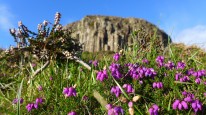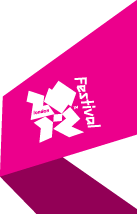Sexy Peat/Tìr mo Rùin
Pàipear-taighe - Deirdre Nelson
See more of Deirdre’s work at http://cargocollective.com/dstitch
6 October: Pàipear-taighe
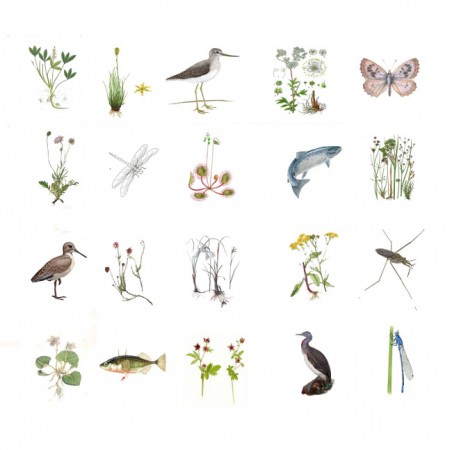
I have been gathering imagery of all the small things from the moor and on my last visit to Lewis I visited Alison Macleod in her studio.

She is a textile designer/artist from The Isle of Lewis whose designs are inspired by her native Hebridean heritage. Many thanks to Alison for allowing me to photograph her wallpaper scrap collection which has been donated by many local people on the island.
One of the wallpapers has provided inspiration for digital manipulation in Photoshop leading to design ideas for digital print.



![]()
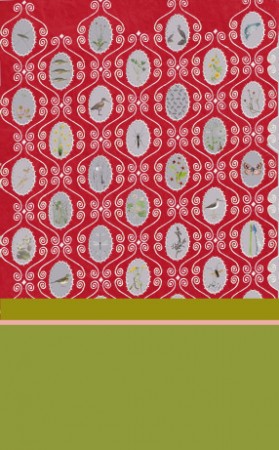
29 September: A’deilbh na Tíre/Patterning the land

I have just returned from Highland Print Makers and had a great few days learning about Printmaking and creating a split edition print for the project. Developing ideas of ‘patterning the land’ and celebrating the ‘patterned‘ women that walked the moor, I have been drawing the small plants and flowers on the moor. These have been created on film and exposed to screen in preparation for printing onto a digital image.
Working with John Mc Naught, I have learned alot about the subtleties of screen printing, colour mixing and layering of inks to create subtle effects.


10 August: Bàn

Let me introduce you to Bàn, (born 2010), daughter of Elizabeth (b. 2008), daughter of Seumas (b. 2005), daughter of Hamish (b. 1999).
Bàn has kindly donated a fleece to the Tìr mo Rùin project. I have been told that sheep have an innate sense of the moor so it seems only right to use materials with association with the bog and its social history. Fellow Tìr mo Rùin artist Anne Campbell has been gathering a beautiful glossary of gaelic terms associated with the moor. I particularly like this one about sheep returning to the moor.
‘astar, sheep will always return to the area of moor in which they spent their first summer. This is called their astar or innis.’
I managed to contact Barvas Spinning group and Rhoda kindly did a mailout to members to see if anyone was up for spinning Bàn’s lovely coat. Margaret from the group was up for the challenge so watch this space for further news of Bàn home spun wool.
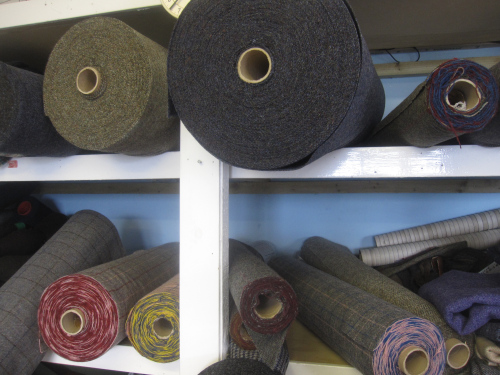
While on Lewis, (with the help of Mary Smith) I travelled to Ness to visit Callum MacLean at Butt of Lewis Textiles . It took us a while to find his house and anonymous weaving shed and we had to stop and ask crofters,who were in the process of shearing a sheep, for directions. He was working in the mill but his wife kindly showed us around his weaving shed. I naively thought I may be able to commission a piece of tweed or collaborate with Callum but he is so busy with mill orders and working both at Carloway mill and at his weaving shed at home that it was not possible. However I did buy a beautiful piece of dark tweed which I hope to embroider for the project. It is fantastic to hear that weavers on Lewis are busy and that their skills and wonderful tweeds are in demand.
Hand-made, home-made
The growth in demand has ensured there’s also a demand for more weavers. At present, there are about 150 self-employed islanders who weave at their homes. Most are in Lewis. There are a further 125 people working in the three Lewis mills and at the Harris Tweed Authority, set up by law to protect its status. Most of the weavers supply the mills, while a few are independent, designing their own fabrics, often for the craft market. Twenty-two young islanders have been put through a training course, and more are being sought. One of the graduates is Heather MacLeod, 22, from Tarbert on Harris. She is the granddaughter of a weaver, and observes: “There’s a need for younger weavers to take up the trade. There’s a lot of people going back to doing home industries – candle-making, soap-making. These are companies that are thriving just now and everybody is looking for things that are hand-made and home-made. It’s coming back, and there are plenty opportunities for people”.
Harris tweed weaving a brighter future BBC news.
Butt of Lewis Textiles weaves Harris Tweed and designs and produces unique tweeds to bespoke design. All stages of tweed preparation and weaving are made by hand. The bobbins are used to warp the tweed first of all. The warp being handmade to ready a tweed for the loom. After the design of the tweed has been decided on, the warp is put on a beam, then the threads (700 threads for the 75cm, 1400 for the 150cm) are knotted one by one by hand. This has to be double checked for perfection of the pattern of the tweed before the weaving of the cloth begins.
Once woven, the tweed has to be finished, washed, scoured, then dried in a special machine and given a blown finished if required. In the case of Harris Tweed the cloth will then be stamped with the world famous Orb mark to certify that it is genuine.
3 August: Micro and macro
I have been finding it difficult to describe our amazing walk and overnight stay on the shieling but when reading Alice Starmore’s writing on the shieling I was really interested in her descriptions of ‘micro and macro’ on the moor. This connects well with my interest in the small things and the ‘micro’ of the moor.
“We lived on the border between micro and macro – our detailed observations were balanced against the broad sweep of the open moor”
I have been told that a local councillor described the moor as ‘a vast are of nothingness’. I wonder if he has walked the moor and taken time to observe the ‘micro.’
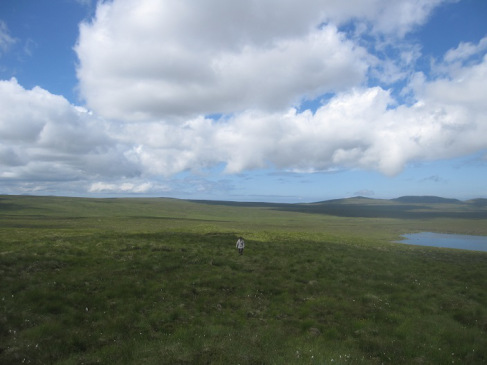
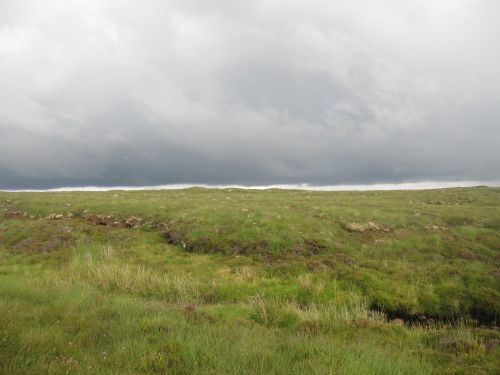

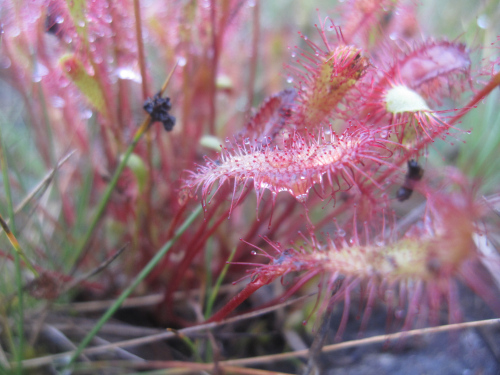

2 August: Cheo geal ri canach an t-sléibe: ‘as white as the bog cotton’
‘If our peatlands were about wildlife and wilderness in the twentieth century, the conservation and restoration of peatlands today is as much about us and our climate. Peat is a glutton for carbon, and the more that is sequestered in the sodden peats of our wetlands, the less that is released into the atmosphere to warm the planet (I think of the quantity of carbon in the atmosphere as akin to the tog rating on that duvet: all things being equal, the higher the concentrations or the rating, the warmer we get. The maths is as simple as that).”
A plea for peat; The beauty of the moorland plant cottongrass reminds us why our peat bogs desperately need saving. Andy Byfield. Guardian. 25 July 2013
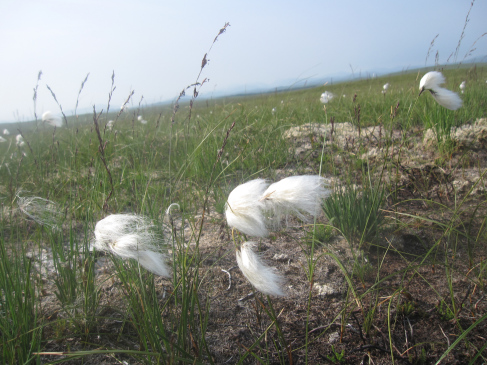
Canach. Common cottongrass, Bog Cotton (Eriophorum angustiflorioum)
When walking on the moor Anne told me of a pair of gloves made from bog cotton which were made by a local lady in the past. I can’t imagine how it was made with the short wispy fibres but would have loved to see them to investigate. On a guided moor walk, Ruaraidh Maclean gave us more fascinating information on bog cotton, gaelic language of the moor and of many other plants and flowers of the bog.
Carmicheal says that a highland girl was not considered fit for marriage, an Dèanadh i lein canaich dha leannan agus paidhir stocainnean dhi fhein’ until she made a shirt of the mountain down for her lover and a pair of stockings for herself (Carmina Gadelica VI)
Garments were made from bog cotton at the Great exhibition in 1851:
Mr Mac Dougall has been attempting to get up new native dyes and new native material for cloths. He exhibited two stuffs which were great curiosities in their way. One cloth was made out of the down of bog cotton and the other cloth made of the fur of the white or alpine hare. (The Great Exhibition of 1851)
Coinneach Dhearg, Coinneach Liath, Mointeach Liath Mosses including Sphagnum Moss
Coinneach applies in general to mosses and also sphagnum. Gathered and dried in the sun, coinneach is highly absorbent and mildly antiseptic:
When they are in any fatigue by travel or otherwise, they fail not to bathe their feet in warm water wherein red moss has been boiled and rub them with it on going to bed. (Martin Martin, A description of the Western Islands of Scotland 1703)
Driuchd na Maidne Round leaved sundew (drosera rotundifolia)
The plant is sufficiently caustic to erode the skin; some ladies mix the juice with milk so as it make it an innocent and safe application to remove freckles and sunburns (McNeill)
30 July: Extreme knitting on the moor
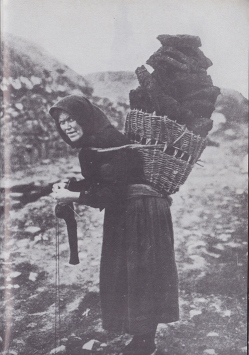
Photo by R Smith and Sons
Apparently women in the past would knit on their way to the shieling and when visiting others in shielings near by. I have been thinking of how difficult it must have been walking over moorland and trying to knit at the same time .
I thought I would give it a go and brought along some Carloway Mill yarn and needles. It wasn’t quite as difficult as I thought and I imagine the knit walkers were well practiced both in knitting and walking the moorland, their hands and feet intuitively moving along with ease. The paths were much clearer at that time as more animals and people would be passing across the moor.
For those of you wishing to give it a go here are some top tips for knitting and walking!
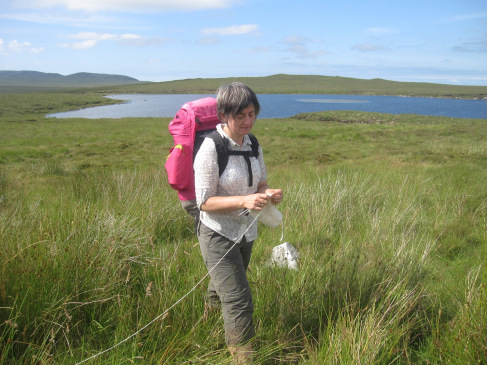
Ashley at Stornoway museum told me that they have a sock in the collection which was found on the peat bog so I look forward to seeing that in their archives.
30 July: On the move
In an attempt to understand more about people and their connection to the moorland, I have been reading about transhumance and shielings. Transhumance is the transfer of livestock from one grazing ground to another, as from lowlands to highlands, with the changing of seasons. Shielings served as temporary summer accommodation for those involved in transhumance.
‘The culture of annual migration to the shielings was practised throughout the Outer Hebrides until the Second World War (Miller, 1967). From, ‘Glanadh a’ Bhaile’, or ‘Cleaning of the Village’, in early May when the women and children would direct their animals across the moors to their summertime abode, until ‘Oidhche na h-Iomraich’, or ‘Night of the Flitting’ in September, when they would pack their belongings once more and head back to their crofts on the west coast, the entire three months of summer were spent on the moor. But on the Isle of Lewis, despite the necessity for transhumance having been long negated, there remain a stalwart few who still keep the tradition alive by using these humble dwellings as weekend escapes or bases for peat-cutting (Miller: 1967).
There seems to be a sense of romanticism surrounding the shielings amongst the current generation. This is surprising considering the levels of social and economic deprivation in the area until the mid twentieth century (Campbell, 2011). Despite this hardship, many have fond memories and a sense of nostalgia as they recall the summers spent out on the moorlands. The shielings themselves are now a little known part of the history and culture of the north of Lewis. But, there are a few who are attempting to record and illustrate the shielings in order to preserve better both the physical characteristics and essence of the buildings.’
(Catriona. M. Macdonald. Dissertation. Air an Àirigh: People and Place: “The shielings of Cuidhsiadar and Filistcleitir: chronicling the tradition of annual migration to the moors as it was then; investigating the death of transhumance in the area; and examining what exactly the shielings mean now.)
In Stornoway library I found an interesting, if rather miserable, Highland and Island Crofters article in the Scotsman (dated 1878) where life in the shieling was described as ‘abominable’:
‘Then in summer there comes on what a minister of the Free church described as the abominable life of the shieling’
The paper’s ‘special commissioner’ also described crofts as ‘ being perched in every conceivable awkward position upon dreary hillsides‘. I suspect he wasn’t a ‘glass full’ sort of a person!
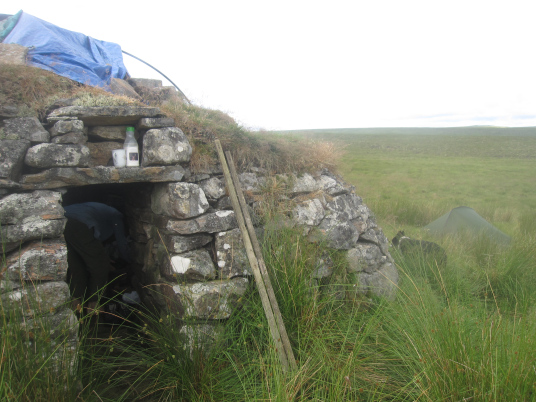
29 July: On the way to the shieling
‘Getting to know the moor through the soles of your feet ‘
Both Anne Campbell and her sister Catriona set off as our guides across the moor walking barefoot to their family shieling. With a desire to embrace the whole experience, I took off my boots and did the same. It was great to feel textures of squelshy peat, soft damp moss, and course heather and, at first, I was surprised how easy it was ( on the way there at least! ) The textures and course heather felt very different on my return journey when my feet were tired, heather scratched and slightly less soft and fresh!
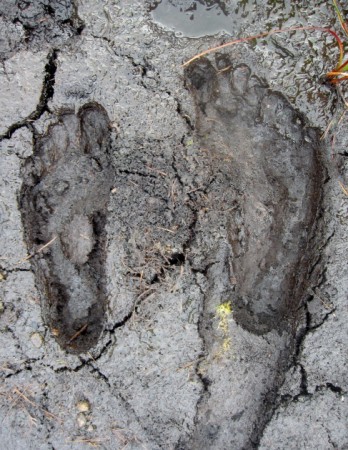
Anne told me about a poem by Derick Thompson, Creachadh na Clarsaich.
I got the feel of you with my feet
I got the feel of you with my feet
in the early summer;
my mind here in the city
strives to know, but the shoes come between us.
the child’s way is difficult to forget:
he rubs himself against his mother
till he finds peace.
I felt the rough side of you and the smooth
and was none the worse of it,
the two sides of the grass, and the two grips on the barley,
peat fibre and moss
And since the world we knew
follows us as far as we go
I need not wash away that mud
from between the boy’s toes.
And now, in middle age
I am going into the fire to warm myself,
with my bare feet on a peat by the hearth.
28 July: Taking the peats home
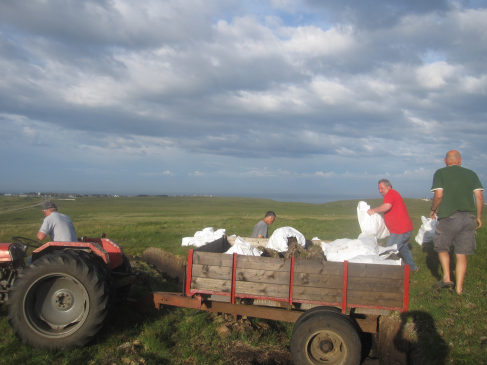
On accepting the kind offer from Marina and Don John (my new friends met on the ferry), I went off to Point to ‘take the peats home’. It was wonderful to take part in such an important event in the family peat calender and I was made to feel most welcome by all present. Don John told me that, in the past, the area would have been full of families collecting their peat, therefore creating a wonderful sense of community and celebration at that time of year. Researching this further, I came across beautiful archive footage of cutting and taking the peats home in Lewis on Scottish Screen Archive.
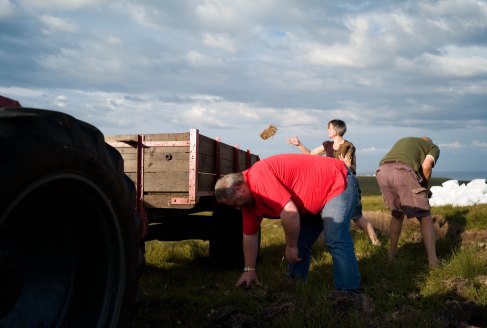
I thoroughly enjoyed the experience and value the opportunity to meet such lovely warm people who welcomed me to their peat bank and home. After a barbecue and much chat, music and hilarity, I even had the experience of throwing the first peat on the fire! Most lucky indeed!
23 July: A ferry journey and two invites

I spotted some knitting in the ferry cafe as I arrived on board. It belonged to Etta, who had been involved in a 24hr knit-a-thon from Butt of Lewis to Barra and was on the ferry collecting money to support a cancer hospice. We got chatting and on hearing about the peat project, she invited me to visit her home area to see some peat cutting. Despite her family having already cut their peat, she offered me a demonstration nonetheless! Later in the journey she introduced me to her friend, and my second peaty invite arrived. Her family were ‘bringing the peat home‘ and I was invited to take part and see how the peat would be stored and laid out at their home. A wee ceilidh was suggested also!
On arrival at Stornoway, I was met by local artist Anne Campbell and fellow peat investigator artist Murray Robertson and off we went to meet Mary Smith. Mary had gathered together information of interest ( songs, poems, imagery and contacts) relating to the peat bog.
So much to think about upon arrival to Lewis!
20 July: Midge net onesie

It’s time to pack for my trip to Lewis to investigate Sexy Peat. Fabric Lenny suggests a midge net onesie as part of my capsule wardrobe!
Often when on residency, I try to travel light and carry minimum art materials and investigate ways of working and making when on location. In this case my essential items are:
notebook
good pen
pencils
camera
laptop
a few needles of the sewing and knitting kind
magnifying glass to look at the small things
measuring tape to measure the small things
Sexy Peat/Pete : Deirdre Nelson is off to Lewis soon
It’s not long now until I head off to Lewis for the Sexy Peat Project . I am excited to be heading there for the first time and to be researching Lewis blanket bog. Many ideas are swimming around but my initial areas of interest are in the social history / people connected to the bog . I am also interested in the overlooked small insect and plant life which inhabit such a vast space.
In initial searching for Sexy Peat I came across the Lewis Peat Calendar.
Watch this space for developments!

